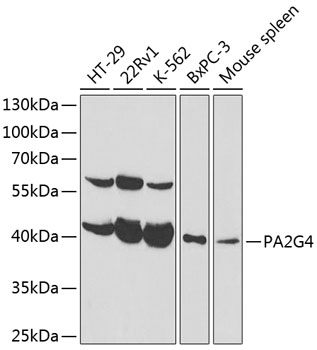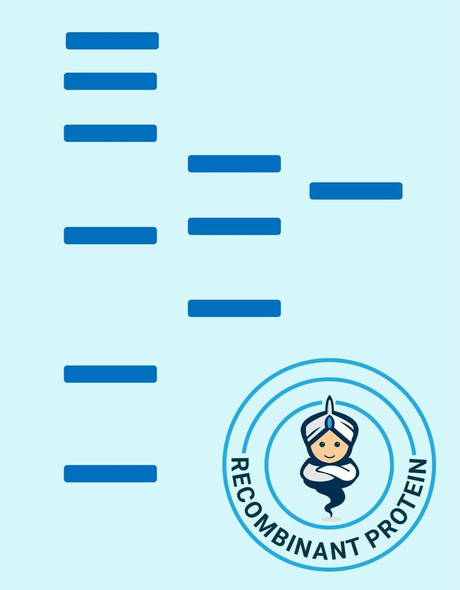Epigenetics & Nuclear Signaling Antibodies 3
Anti-PA2G4 Antibody (CAB14037)
- SKU:
- CAB14037
- Product Type:
- Antibody
- Reactivity:
- Human
- Reactivity:
- Mouse
- Reactivity:
- Rat
- Host Species:
- Rabbit
- Isotype:
- IgG
- Antibody Type:
- Polyclonal Antibody
- Research Area:
- Epigenetics and Nuclear Signaling
Description
| Antibody Name: | Anti-PA2G4 Antibody |
| Antibody SKU: | CAB14037 |
| Antibody Size: | 20uL, 50uL, 100uL |
| Application: | WB IHC IF |
| Reactivity: | Human, Mouse, Rat |
| Host Species: | Rabbit |
| Immunogen: | Recombinant fusion protein containing a sequence corresponding to amino acids 1-394 of human PA2G4 (NP_006182.2). |
| Application: | WB IHC IF |
| Recommended Dilution: | WB 1:500 - 1:2000 IHC 1:50 - 1:100 IF 1:50 - 1:100 |
| Reactivity: | Human, Mouse, Rat |
| Positive Samples: | HT-29, 22Rv1, K-562, BxPC-3, Mouse spleen |
| Immunogen: | Recombinant fusion protein containing a sequence corresponding to amino acids 1-394 of human PA2G4 (NP_006182.2). |
| Purification Method: | Affinity purification |
| Storage Buffer: | Store at -20'C. Avoid freeze / thaw cycles. Buffer: PBS with 0.02% sodium azide, 50% glycerol, pH7.3. |
| Isotype: | IgG |
| Sequence: | MSGE DEQQ EQTI AEDL VVTK YKMG GDIA NRVL RSLV EASS SGVS VLSL CEKG DAMI MEET GKIF KKEK EMKK GIAF PTSI SVNN CVCH FSPL KSDQ DYIL KEGD LVKI DLGV HVDG FIAN VAHT FVVD VAQG TQVT GRKA DVIK AAHL CAEA ALRL VKPG NQNT QVTE AWNK VAHS FNCT PIEG MLSH QLKQ HVID GEKT IIQN PTDQ QKKD HEKA EFEV HEVY AVDV LVSS GEGK AKDA GQRT TIYK RDPS KQYG LKMK TSRA FFSE VERR FDAM PFTL RAFE DEKK ARMG VVEC AKHE LLQP FNVL YEKE GEFV AQFK FTVL LMPN GPMR ITSG PFEP DLYK SEME VQDA ELKA LLQS SASR KTQK KKKK KASK TAEN ATSG ETLE ENEA GD |
| Gene ID: | 5036 |
| Uniprot: | Q9UQ80 |
| Cellular Location: | Cytoplasm, Nucleus, nucleolus |
| Calculated MW: | 38kDa/43kDa |
| Observed MW: | 40kDa |
| Synonyms: | PA2G4, EBP1, HG4-1, p38-2G4 |
| Background: | This gene encodes an RNA-binding protein that is involved in growth regulation. This protein is present in pre-ribosomal ribonucleoprotein complexes and may be involved in ribosome assembly and the regulation of intermediate and late steps of rRNA processing. This protein can interact with the cytoplasmic domain of the ErbB3 receptor and may contribute to transducing growth regulatory signals. This protein is also a transcriptional co-repressor of androgen receptor-regulated genes and other cell cycle regulatory genes through its interactions with histone deacetylases. This protein has been implicated in growth inhibition and the induction of differentiation of human cancer cells. Six pseudogenes, located on chromosomes 3, 6, 9, 18, 20 and X, have been identified. |
| UniProt Protein Function: | Ebp1: May play a role in a ERBB3-regulated signal transduction pathway. Seems be involved in growth regulation. Acts a corepressor of the androgen receptor (AR) and is regulated by the ERBB3 ligand neuregulin-1/heregulin (HRG). Inhibits transcription of some E2F1-regulated promoters, probably by recruiting histone acetylase (HAT) activity. Binds RNA. Associates with 28S, 18S and 5.8S mature rRNAs, several rRNA precursors and probably U3 small nucleolar RNA. May be involved in regulation of intermediate and late steps of rRNA processing. May be involved in ribosome assembly. Mediates cap-independent translation of specific viral IRESs (internal ribosomal entry site). Belongs to the peptidase M24 family. |
| UniProt Protein Details: | Protein type:Nucleolus; Transcription, coactivator/corepressor; Nuclear receptor co-regulator Chromosomal Location of Human Ortholog: 12q13.2 Cellular Component: nucleoplasm; membrane; cytoplasm; nucleolus; nucleus; ribonucleoprotein complex Molecular Function:protein binding; DNA binding; ubiquitin protein ligase binding; transcription factor activity Biological Process: regulation of translation; cell proliferation; transcription, DNA-dependent; negative regulation of transcription, DNA-dependent; positive regulation of cell differentiation; cell cycle arrest; rRNA processing; negative regulation of apoptosis |
| NCBI Summary: | This gene encodes an RNA-binding protein that is involved in growth regulation. This protein is present in pre-ribosomal ribonucleoprotein complexes and may be involved in ribosome assembly and the regulation of intermediate and late steps of rRNA processing. This protein can interact with the cytoplasmic domain of the ErbB3 receptor and may contribute to transducing growth regulatory signals. This protein is also a transcriptional co-repressor of androgen receptor-regulated genes and other cell cycle regulatory genes through its interactions with histone deacetylases. This protein has been implicated in growth inhibition and the induction of differentiation of human cancer cells. Six pseudogenes, located on chromosomes 3, 6, 9, 18, 20 and X, have been identified. [provided by RefSeq, Jul 2008] |
| UniProt Code: | Q9UQ80 |
| NCBI GenInfo Identifier: | 13632817 |
| NCBI Gene ID: | 5036 |
| NCBI Accession: | Q9UQ80.3 |
| UniProt Secondary Accession: | Q9UQ80,O43846, Q9UM59, |
| UniProt Related Accession: | Q9UQ80 |
| Molecular Weight: | 394 |
| NCBI Full Name: | Proliferation-associated protein 2G4 |
| NCBI Synonym Full Names: | proliferation-associated 2G4, 38kDa |
| NCBI Official Symbol: | PA2G4 |
| NCBI Official Synonym Symbols: | EBP1; HG4-1; p38-2G4 |
| NCBI Protein Information: | proliferation-associated protein 2G4; erbB3-binding protein 1; ErbB-3 binding protein 1; ErbB3-binding protein Ebp1; cell cycle protein p38-2G4 homolog; proliferation-associated 2G4, 38kD |
| UniProt Protein Name: | Proliferation-associated protein 2G4 |
| UniProt Synonym Protein Names: | Cell cycle protein p38-2G4 homolog; hG4-1; ErbB3-binding protein 1 |
| Protein Family: | Proliferation-associated protein |
| UniProt Gene Name: | PA2G4 |
| UniProt Entry Name: | PA2G4_HUMAN |
View AllClose





![Anti-PA2G4 Antibody (CAB19972)[KO Validated] Anti-PA2G4 Antibody (CAB19972)[KO Validated]](https://cdn11.bigcommerce.com/s-rd6ounxcu2/images/stencil/590x590/products/56139/61321/anti-pa2g4-antibody-cab19972ko-validated__98891__01208.1706533769.jpg?c=1)
![PA2G4 Monoclonal Antibody [PAT5E7AT] (CPAB0656) PA2G4 Monoclonal Antibody [PAT5E7AT] (CPAB0656)](https://cdn11.bigcommerce.com/s-rd6ounxcu2/images/stencil/590x590/products/58876/64058/assay-genie-box-4__41384.1706535245.jpg?c=1)
